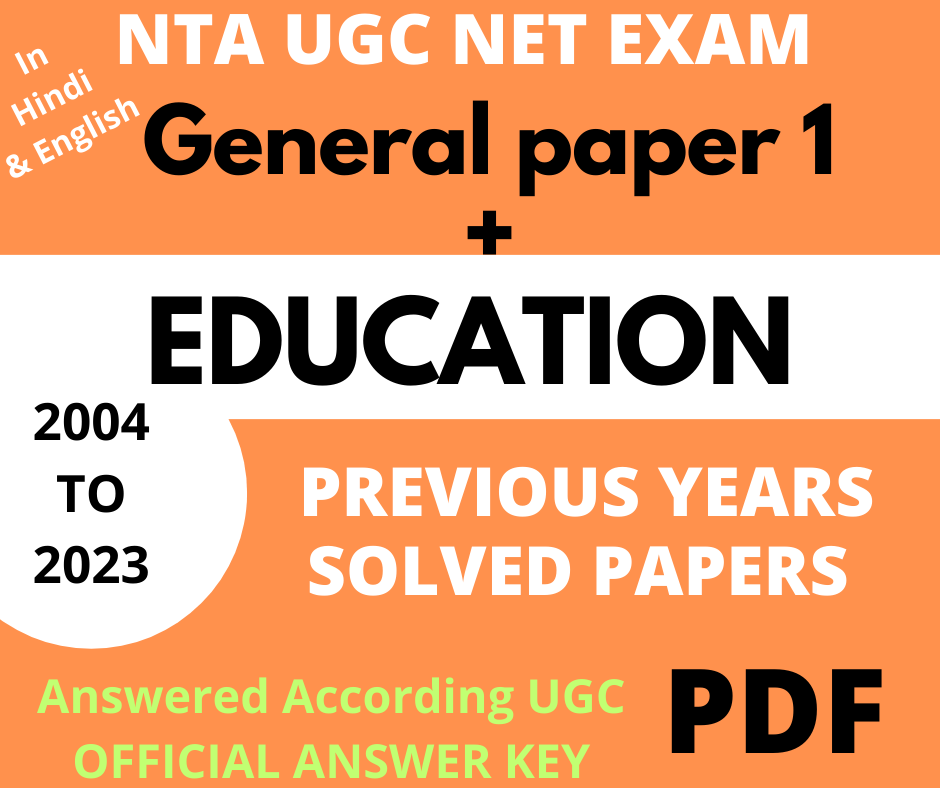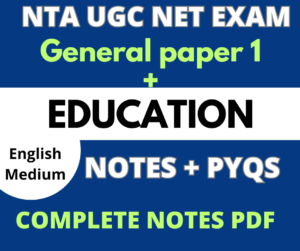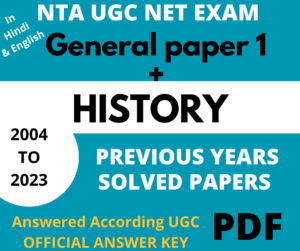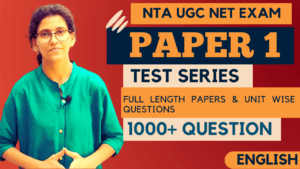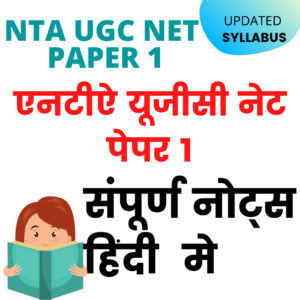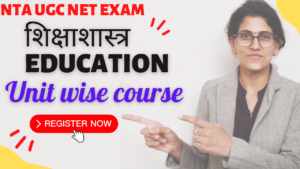June 2019 all MCQs of Research Aptitude with answer. this will help you to understand what types of question NTA focusing in their UGC NET EXAM.
1. A tentative proposition with unknown validity that specifies a relationship between two or more variables is called
(1) Research problem
(2) Research proposal
(3) Research design
(4) Research hypothesis
1. A tentative proposition with unknown validity that specifies a relationship between two or more variables is called
(1) Research problem
(2) Research proposal
(3) Research design
(4) Research hypothesis
2. ERIC, MEDLINE and ABI/INFORM are instances of
(1) Citation Services
(2) Electronic Databases
(3) Printed Databases
(4) Libraries
2. ERIC, MEDLINE and ABI/INFORM are instances of
(1) Citation Services
(2) Electronic Databases
(3) Printed Databases
(4) Libraries
3. In which of the following research paradigms the focus of concern is on
interpreting reality in terms of participants’ perspective?
(A) Experimental Research
(B) Ex-Post Facto Research
(C) Ethnographic Research
(D) Survey Researches
3. In which of the following research paradigms the focus of concern is on
interpreting reality in terms of participants’ perspective?
(A) Experimental Research
(B) Ex-Post Facto Research
(C) Ethnographic Research
(D) Survey Researches
4. Research design that needs to collect factual information on a continuing basis is classified as
(A) Longitudinal Study Design
(B) Pre and Post Study Design
(C) Cross Sectional Study Design
(D) Double Control Study Design
4. Research design that needs to collect factual information on a continuing basis is classified as
(A) Longitudinal Study Design
(B) Pre and Post Study Design
(C) Cross Sectional Study Design
(D) Double Control Study Design
5. Snowball sampling is a process of selecting a sample using
(A) Networks
(B) Groups
(C) Snowballs
(D) Computer Programs
5. Snowball sampling is a process of selecting a sample using
(A) Networks
(B) Groups
(C) Snowballs
(D) Computer Programs
6. From the list given below identify those questions which are called process rather than content based questions?
i. Convergent questions
ii. Divergent questions
iii. Fact based questions
iv. Concept based questions
v. Open questions
vi. Closed questions
Choose the correct answer from the options given below:
A. (i), (ii) and (iii)
B. (ii), (iii) and (iv)
C. (iv), (v) and (vi)
D. (ii), (iv) and (v)
6. From the list given below identify those questions which are called process rather than content based questions?
i. Convergent questions
ii. Divergent questions
iii. Fact based questions
iv. Concept based questions
v. Open questions
vi. Closed questions
Choose the correct answer from the options given below:
A. (i), (ii) and (iii)
B. (ii), (iii) and (iv)
C. (iv), (v) and (vi)
D. (ii), (iv) and (v)
7. A shift in attitude in respondents between two points during data collection is called
A. Reactive effect
B. Maturation effect
C. Regression effect
D. Conditioning effect
7. A shift in attitude in respondents between two points during data collection is called
A. Reactive effect
B. Maturation effect
C. Regression effect
D. Conditioning effect
8. The major characteristic of correlation analysis is to seek out
A. Differences among variables
B. Variation among variables
C. Association among variables
D. Regression among variables
8. The major characteristic of correlation analysis is to seek out
A. Differences among variables
B. Variation among variables
C. Association among variables
D. Regression among variables
9. The time frame in which a study explores a situation or problem is called the
A. Reference period
B. Age
C. Longitudinal
D. Retrospective time
9. The time frame in which a study explores a situation or problem is called the
A. Reference period
B. Age
C. Longitudinal
D. Retrospective time
10. The conceptual framework in which a research is conducted is called a
A. Synopsis of research
B. Research design
C. Research hypothesis
D. Research paradigm
10. The conceptual framework in which a research is conducted is called a
A. Synopsis of research
B. Research design
C. Research hypothesis
D. Research paradigm
11. A pilot study is also called a
A. Descriptive study
B. Feasibility study
C. Correlational study
D. Explanatory study
11. A pilot study is also called a
A. Descriptive study
B. Feasibility study
C. Correlational study
D. Explanatory study
12. The fish bowl draw is a method of drawing a/an
A. Independent sample
B. Structured sample
C. Non-random sample
D. Random sample
12. The fish bowl draw is a method of drawing a/an
A. Independent sample
B. Structured sample
C. Non-random sample
D. Random sample
13. Which of the following research type has a potential for enhancing teaching competencies?
A. Fundamental research
B. Applied research
C. Impact assessment research
D. Action research
13. Which of the following research type has a potential for enhancing teaching competencies?
A. Fundamental research
B. Applied research
C. Impact assessment research
D. Action research
14. In experimental based research studies the observations derived from which of the following variables are considered for statistical analysis?
A. Independent variable
B. Dependent variable
C. Moderator variable
D. Control variable
14. In experimental based research studies the observations derived from which of the following variables are considered for statistical analysis?
A. Independent variable
B. Dependent variable
C. Moderator variable
D. Control variable
15. A questionnaire that offers no scope for any respondent’s own view is called
A. Closed ended
B. Schedule
C. Open ended
D. Unstructured
15. A questionnaire that offers no scope for any respondent’s own view is called
A. Closed ended
B. Schedule
C. Open ended
D. Unstructured
Q.16 In research, reliability is that quality of a measurement procedure which provides
A. Repeatability and accuracy
B. Punctuality and accuracy
C. Accuracy and speed
D. Speed and repeatability
Q.16 In research, reliability is that quality of a measurement procedure which provides
A. Repeatability and accuracy
B. Punctuality and accuracy
C. Accuracy and speed
D. Speed and repeatability
Q.17 When researcher does not know identity of the experimental and placebo groups, the study is termed as
A. Blind
B. Double-blind
C. Panel
D. Cohort
Q.17 When researcher does not know identity of the experimental and placebo groups, the study is termed as
A. Blind
B. Double-blind
C. Panel
D. Cohort
Q.18 Research that focuses on social inequality between men and women is called
A. Comparative research
B. Longitudinal research
C. Action research
D. Feminist research
Q.18 Research that focuses on social inequality between men and women is called
A. Comparative research
B. Longitudinal research
C. Action research
D. Feminist research
Q.19 The easiest attitudinal scale which is summated rating scale is the
A. Guttman scale
B. Likert scale
C. Thurstone scale
D. MLA stone
Q.19 The easiest attitudinal scale which is summated rating scale is the
A. Guttman scale
B. Likert scale
C. Thurstone scale
D. MLA stone
Q.20 In the research method, generalizations may be made that will be applicable to other situations of the same type. What is this called?
A. Cohort Study
B. Case Study
C. Panel Study
D. Blind Study
Q.20 In the research method, generalizations may be made that will be applicable to other situations of the same type. What is this called?
A. Cohort Study
B. Case Study
C. Panel Study
D. Blind Study
Q.21 Quantitative research is also called the
A. Ethnographic approach
B. Unstructured approach
C. Descriptive approach
D. Structured approach
Q.21 Quantitative research is also called the
A. Ethnographic approach
B. Unstructured approach
C. Descriptive approach
D. Structured approach
Q.22 The study of why does stressful result in heart attack? Can be classified as
A. Descriptive research
B. Explanatory research
C. Correlational research
D. Feasibility research
Q.22 The study of why does stressful result in heart attack? Can be classified as
A. Descriptive research
B. Explanatory research
C. Correlational research
D. Feasibility research
Q.23 A hypothesis should be conceptually
A. Convoluted, complex and generic
B. Complex, tough and general
C. Simple, clear and specific
D. Obscure, complicated and simple
Q.23 A hypothesis should be conceptually
A. Convoluted, complex and generic
B. Complex, tough and general
C. Simple, clear and specific
D. Obscure, complicated and simple
Q.24 Mailed questionnaire observation, interview and collective questionnaire are instances of
A. Secondary source
B. Personal source
C. Primary source
D. Tertiary source
Q.24 Mailed questionnaire observation, interview and collective questionnaire are instances of
A. Secondary source
B. Personal source
C. Primary source
D. Tertiary source
Q.25 The formulation of a research problem can be compared to
A. Laying the foundation of a building
B. Building the walls of a home
C. Painting the doors of a building
D. Constructing the ceiling of a house
Q.25 The formulation of a research problem can be compared to
A. Laying the foundation of a building
B. Building the walls of a home
C. Painting the doors of a building
D. Constructing the ceiling of a house
Q.26 During research, while recording observations if an observer refers an individual based on the rating given in another aspect of interaction, this is termed as the
A. Evaluation Effect
B. Error of central tendency
C. Halo effect
D. Categorical effect
Q.26 During research, while recording observations if an observer refers an individual based on the rating given in another aspect of interaction, this is termed as the
A. Evaluation Effect
B. Error of central tendency
C. Halo effect
D. Categorical effect
Q.27 The research design is specifically related to which of the following features in research? Select your answer from the options given below.
1. Sample selection
2. Formulation of a plan
3. Deciding about the tool for data collection
4. Hypothesis making
5. Choice of a field of inquiry
A. (i), (iii) and (iv)
B. (i), (ii) and (iii)
C. (ii), (iv) and (v)
D. (iii), (iv) and (v)
Q.27 The research design is specifically related to which of the following features in research? Select your answer from the options given below.
1. Sample selection
2. Formulation of a plan
3. Deciding about the tool for data collection
4. Hypothesis making
5. Choice of a field of inquiry
A. (i), (iii) and (iv)
B. (i), (ii) and (iii)
C. (ii), (iv) and (v)
D. (iii), (iv) and (v)
Q.28 Bibliography given in a research report
A. Helps those interested in further research
B. Shows vast knowledge of the researcher
C. Makes the report authentic
D. Is an optional part of the report
Q.28 Bibliography given in a research report
A. Helps those interested in further research
B. Shows vast knowledge of the researcher
C. Makes the report authentic
D. Is an optional part of the report
Q.29 Through which research method, the manipulation of an independent variable and its effect on dependent variable is examined with reference to a hypothesis under controlled conditions?
A. Ex-Post facto research
B. Descriptive research
C. Case study research
D. Experimental research
Q.29 Through which research method, the manipulation of an independent variable and its effect on dependent variable is examined with reference to a hypothesis under controlled conditions?
A. Ex-Post facto research
B. Descriptive research
C. Case study research
D. Experimental research
Q30. In which of the following research studies interpretation and meaning get more attention than formulation of generalization?
Choose your answer from the options given below.
1. Historical studies
2. Survey Studies
3. Philosophical studies
4. Ethnographic studies
5. Hypothetical-deductive studies
6. Ex-post facto studies
A. (i), (ii) and (iii)
B. (iv), (v) and (vi)
C. (ii), (iv) and (v)
D. (i), (iii) and (iv)
Q30. In which of the following research studies interpretation and meaning get more attention than formulation of generalization?
Choose your answer from the options given below.
1. Historical studies
2. Survey Studies
3. Philosophical studies
4. Ethnographic studies
5. Hypothetical-deductive studies
6. Ex-post facto studies
A. (i), (ii) and (iii)
B. (iv), (v) and (vi)
C. (ii), (iv) and (v)
D. (i), (iii) and (iv)
horQ.31 Which stage in research creates a working thesis for the research paper by specifying and organising the category of information?
A. Research design
B. Developing a hypothesis
C. Review of literature
D. Analysis of data
Q.31 Which stage in research creates a working thesis for the research paper by specifying and organising the category of information?
A. Research design
B. Developing a hypothesis
C. Review of literature
D. Analysis of data
Q.32 A good review of research literature aims at
A. Subjective analysis of the content
B. Provides information about the authors and their affiliations
C. Generates research questions and validating those questions
D. Conducts multiple task based on screening
Q.32 A good review of research literature aims at
A. Subjective analysis of the content
B. Provides information about the authors and their affiliations
C. Generates research questions and validating those questions
D. Conducts multiple task based on screening
Q.33 Which of the following research formats focuses on hypothesis testing and generalisations?
A. Experimental and Ex post facto research
B. Intervention based action research
C. Phenomenological and narrative research
D. Case study research
Q.33 Which of the following research formats focuses on hypothesis testing and generalisations?
A. Experimental and Ex post facto research
B. Intervention based action research
C. Phenomenological and narrative research
D. Case study research
Q.34 Which one of the following is the main feature of Qualitative research?
A. Avoids Positivists assumptions and data analysis
B. Subscribe to pre-existing categories
C. Collects data in numeral form
D. Use empirical method of data analysis
Q.34 Which one of the following is the main feature of Qualitative research?
A. Avoids Positivists assumptions and data analysis
B. Subscribe to pre-existing categories
C. Collects data in numeral form
D. Use empirical method of data analysis
Q.35 A researcher falls to reject the null hypothesis (Ho) in his/her research. What implications will it carry for his/her principle research hypothesis?
A. Accepting the research hypothesis
B. Rejecting the research hypothesis
C. Not taking any decision on the research hypothesis
D. Improving the research hypothesis
Q.35 A researcher falls to reject the null hypothesis (Ho) in his/her research. What implications will it carry for his/her principle research hypothesis?
A. Accepting the research hypothesis
B. Rejecting the research hypothesis
C. Not taking any decision on the research hypothesis
D. Improving the research hypothesis
Q.36 Which of the following action sets best represent an action research cycle?
A. Reflect, act, plan and observe
B. Plan, act, observe and reflect
C. Observe, plan, reflect and act
D. Act, plan, observe and reflect
Q.36 Which of the following action sets best represent an action research cycle?
A. Reflect, act, plan and observe
B. Plan, act, observe and reflect
C. Observe, plan, reflect and act
D. Act, plan, observe and reflect
Q.37 A Hypothesis is
A. A certain and established finding
B. A part of the research question
C. A strategy of evaluating data
D. A tentative statement providing explanation
Q.37 A Hypothesis is
A. A certain and established finding
B. A part of the research question
C. A strategy of evaluating data
D. A tentative statement providing explanation
Q.38 Position papers are
A. Compiling of academic articles
B. Providing review articles
C. Offering a synopsis of an extended research
D. Highlighting of issues and depiction of status
Q.38 Position papers are
A. Compiling of academic articles
B. Providing review articles
C. Offering a synopsis of an extended research
D. Highlighting of issues and depiction of status
Q.39 From the following list identify the qualitative research characteristics and select your answer from the codes given below:
1. Creating purpose statements and research questions
2. Stating the purpose and research questions in a broad way
3. Collecting data based on words from a small number of individuals
4. Collecting numeric data and statistical analysis
5. Using text analysis and interpreting larger meanings of findings
Code:
A. (i), (iii) and (v)
B. (i), (ii) and (iii)
C. (i), (ii) and (iv)
D. (i), (iii) and (v)
Q.39 From the following list identify the qualitative research characteristics and select your answer from the codes given below:
1. Creating purpose statements and research questions
2. Stating the purpose and research questions in a broad way
3. Collecting data based on words from a small number of individuals
4. Collecting numeric data and statistical analysis
5. Using text analysis and interpreting larger meanings of findings
Code:
A. (i), (iii) and (v)
B. (i), (ii) and (iii)
C. (i), (ii) and (iv)
D. (i), (iii) and (v)
Q.40 Case studies are
A. Studies conducted in areas of genetics and microbiology
B. In-depth examination of a subject and its related conditions
C. A report on the existing socio-political condition
D. Specialized research in the areas of health and sanitation
Q.40 Case studies are
A. Studies conducted in areas of genetics and microbiology
B. In-depth examination of a subject and its related conditions
C. A report on the existing socio-political condition
D. Specialized research in the areas of health and sanitation
Q.41 Tertiary source of data is
A. Films, boarding and posters
B. Government gazettes, newspapers and magazines
C. Information derived from both primary and secondary sources
D. Data collected from policy papers
Q.41 Tertiary source of data is
A. Films, boarding and posters
B. Government gazettes, newspapers and magazines
C. Information derived from both primary and secondary sources
D. Data collected from policy papers
Q.42 Participant observation is a part of
A. Philosophical research
B. Mentalist Theory of language
C. Mathematical research
D. Ethnographic research
Q.42 Participant observation is a part of
A. Philosophical research
B. Mentalist Theory of language
C. Mathematical research
D. Ethnographic research
Q.43 Critical language testing in a research report is
A. Testing language from an ethical point of view, revealing its misuses
B. Evaluating the stylist characteristics of language
C. Critiquing the ideology of the author
D. Observing the gender role played by language
Q.43 Critical language testing in a research report is
A. Testing language from an ethical point of view, revealing its misuses
B. Evaluating the stylist characteristics of language
C. Critiquing the ideology of the author
D. Observing the gender role played by language
Q.44 Think-aloud procedure is
A. A part of secondary source of data
B. A technique used to investigate learner strategies and performance
C. A strategy of testing learners’ aptitude by providing primary sources
D. A necessary method in scientific research
Q.44 Think-aloud procedure is
A. A part of secondary source of data
B. A technique used to investigate learner strategies and performance
C. A strategy of testing learners’ aptitude by providing primary sources
D. A necessary method in scientific research
Q.45 Plagiarism in research is
A. Creative use of previous data
B. Copying unscrupulously and making use of it
C. Quoting someone and citing him/her
D. Referring to previous data and working over it with new objectives
Q.45 Plagiarism in research is
A. Creative use of previous data
B. Copying unscrupulously and making use of it
C. Quoting someone and citing him/her
D. Referring to previous data and working over it with new objectives
Q.46 ensuring the improvement of the professional as well as work situation?
A. Fundamental Research
B. Applied Research
C. Evaluation Research
D. Action Research
Q.46 ensuring the improvement of the professional as well as work situation?
A. Fundamental Research
B. Applied Research
C. Evaluation Research
D. Action Research
Q.47 After identifying the different variables and establishing the logical reasoning in theoretical framework, the next step in the research
A. Conduct survey
B. Generate hypothesis
C. Focus on group discussion
D. Use experiment in an investigation
Q.47 After identifying the different variables and establishing the logical reasoning in theoretical framework, the next step in the research
A. Conduct survey
B. Generate hypothesis
C. Focus on group discussion
D. Use experiment in an investigation
Q.48 Participation in which type of research has the great potential for ensuring the improvement of the professional as well as work situation?
A. Fundamental Research
B. Applied Research
C. Evaluation Research
D. Action Research
Q.48 Participation in which type of research has the great potential for ensuring the improvement of the professional as well as work situation?
A. Fundamental Research
B. Applied Research
C. Evaluation Research
D. Action Research
Q.49 Plagiarism in research is
A. Creative use of previous data
B. Copying unscrupulously and making use of it
C. Quoting someone and citing him/her
D. Referring to previous data and working over it with new objectives
Q.49 Plagiarism in research is
A. Creative use of previous data
B. Copying unscrupulously and making use of it
C. Quoting someone and citing him/her
D. Referring to previous data and working over it with new objectives
